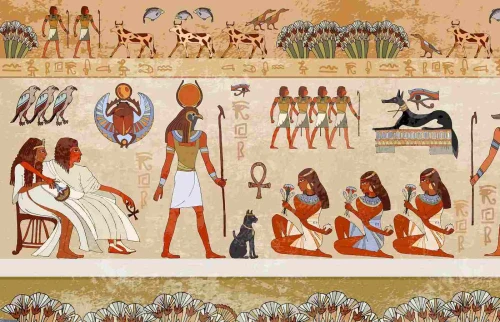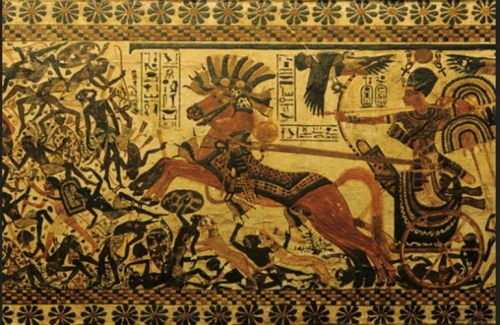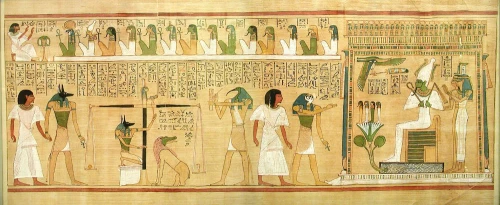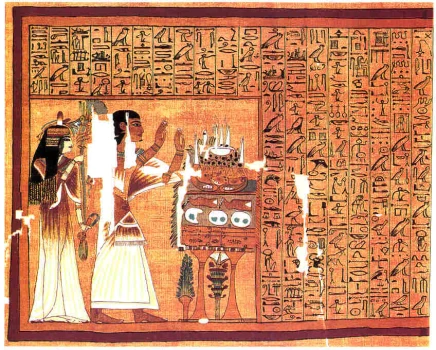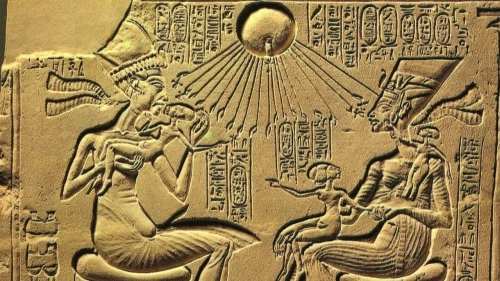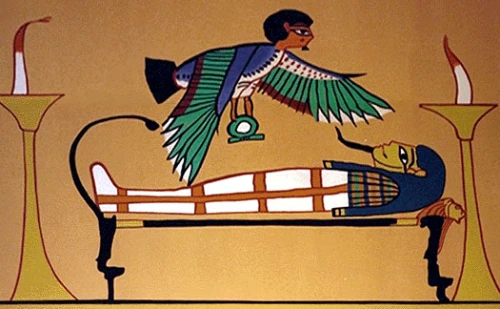
DREAMS The Egyptians believed that their dreams were sent by the gods as a means of telling the future. The frequency with which dreams are mentioned in the first two books of the Old Testament indicates just how important dreams were in the ancient world. In Genesis alone, there are more than a dozen references to dreams, most of the prophetic.
The Old Testament story of Joseph and his brothers reveals much about ancient beliefs in prophetic dreams. Joseph was sold into slavery partly because he had dreams that foretold he would rule over his brothers (35:5 - 11). Later, when Joseph was in jail in Egypt with two of the pharaoh's former officials, a cupbearer, and a baker, they told him that they had had dreams but that they could not understand them. Joseph correctly interpreted the dreams to mean that in three days the cupbearer would be released and the baker hanged. Joseph was released from prison when he was called upon to interpret the pharaoh's dreams that the royal magicians had failed to decipher. In the first dream, the pharaoh had seen seven fat cows devoured by seven lean cows.
In the pharaoh's second dream, seven meager ears swallowed seven full ears of corn. Joseph told the pharaoh the dreams meant that Egypt would have seven years of prosperity followed by seven years of famine; the people would have to plan accordingly to avoid mass starvation. Archaeological evidence also provides us with an account of the Egyptians' belief in prophetic dreams. The case of Thutmose IV (1400 - 1390 B.C) is perhaps the most famous. At the foot of the Great Sphinx is a stele that tells of a dream by the young prince who was to become Thutmose IV.
The prince was hunting in the desert one day and stopped at noon for a nap, near where the Great Sphinx lay partially buried in the sand. The prince dreamed that the Sphinx told him if he cleared away the sand that covered it, the young prince would become pharaoh. He cleared the sand from the Sphinx, and he became pharaoh. The stele supports the impression given in Genesis and Exodus that the ancient Egyptians believed strongly in prophetic dreams. In the Joseph story, the pharaoh had enough confidence in Joseph's interpretation of his dreams to place him in charge of the country's economic future for the next 14 years.
An almost complete Dream Book from a hieratic papyrus in the British Museum gives some idea of how the ancient Egyptians interpreted dreams. The book is written on the recto side (front) of papyrus, but some sections have been lost. The verso (back), the side with the horizontal fibers on top (and the side easier to write on), describes a battle and includes a copy of a letter to the vizier of Egypt. This site was undoubtedly written during the Nineteenth Dynasty (1295 - 1186 B.C). Since the verso or back side is always written first, the Dream Book was certainly written later. This version of the Dream Book may have been copied from an earlier papyrus originating in the Twelfth Dynasty (1985 - 1795 B.C). As so often happens with papyrus, the beginning and the ending are damaged. What remains is a list of dreams and their interpretations. One wonders for whom the papyrus was intended. Since the common man could not read, one possibility is that, as part of their duties, the priests interpreted dreams. This would be consistent with accounts in the Bible, in which only a select few were able to interpret dreams. Hieroglyphs suggest that the priests of the House of Life were the interpreters. Coptic writing, which is ancient Egyptian transcribed in Greek letters with a few characters added, is the strongest connection we have with vocalized ancient Egyptians. In the Coptic (Bohairic) version of the Bible, when the PHA rash calls for his dream interpreters, the word used for interpreters is seshperonch.
This is probably a corruption of sesh-per-ankh scribe of the House of Life. It was common practice for anyone seeking divine guidance to spend a night in the temple, where the priests, for a fee, would interpret the person's dream. Sleeping in a temple to obtain dream oracles was virtually required for any Greek tourist in Egypt, and the Temple of Seti at Abydos was a favorite dream spot. On the walls of the back staircase in the temple are names carved by tourists who slept there. The names are often only a foot or so above the steps, so it seems as if at least some of these travelers passed the hours of the night carving their names. One group recorded, that they caught a fox here. The Dream Book was written in hieratic, a cursive form of hieroglyphs, and is organized in an orderly fashion, from right to left. Down the right margin are the words, If a man sees himself in a dream. Each horizontal line describes a dream, followed by the interpretation of the dream. Each interpretation begins with either Good or Bad, followed by an explanation. The following is a partial listing of the Dream Book and its interpretations.
Dream P prophecy Killing an ox Good. It means the removal of the dreamer's enemies from his presence. Writing on Good. It means the palette dreamer's status is well established. Drinking blood is Good. It means putting an end to his enemies. Picking dates Good. It means finding food given by a god. Seeing a large cat is Good. It means a large harvest is coming to the dreamer. Copulating with Bad. It means being a pig deprived of possessions. Uncovering his Bad. It means the dreamer's backside will become an orphan later. Climbing on Good. It means being a mast suspended aloft by a god. Drinking wine is Good. It means living in righteousness. Seeing his face was Good. It means gaining as a leopard authority over his townsfolk. Capturing a Good. It means something female slave from which he will have satisfaction.
There seems to be no common theme or technique in the interpretation of the dreams. It may have been that the list was compiled over years and the interpretations changed over time. DUAMUTEF One of the four sons of Horus who guarded the internal organs of the mummy. Duamutef protected the stomach. Duamutef has the head of a jackal. DUAT A place of darkness and home of terrifying demons, the Duat was a mythological location between the world of the living and the world of the dead.
The Amduat, The Book of That Which is in the Netherworld, says the Duat is located deep in a valley that separates Earth from the Netherworld. When Re the sun god sinks below the horizon at the end of each day to begin the 12-hour journey he is accompanied by the souls of the deceased. Only those souls found to be pure after the Weighing of the Heart Ceremony is allowed to accompany the sun god on this perilous journey. At the end of the twelfth hour, after successfully battling and overpowering evil demons that menace the sun god at every hour, Re and the souls emerge safely into the welcoming realm of the sky goddess, Nut. He appears on the horizon to begin a new day, and the souls prepare for resurrection in the Netherworld.
 English
English
 Spain
Spain

